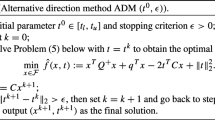Abstract
We consider in this paper a separable and nonconvex quadratic program (QP) with a quadratic constraint and a box constraint that arises from application in optimal portfolio deleveraging (OPD) in finance and is known to be NP-hard. We first propose an improved Lagrangian breakpoint search algorithm based on the secant approach (called ILBSSA) for this nonconvex QP, and show that it converges to either a suboptimal solution or a global solution of the problem. We then develop a successive convex optimization (SCO) algorithm to improve the quality of suboptimal solutions derived from ILBSSA, and show that it converges to a KKT point of the problem. Second, we develop a new global algorithm (called ILBSSA-SCO-BB), which integrates the ILBSSA and SCO methods, convex relaxation and branch-and-bound framework, to find a globally optimal solution to the underlying QP within a pre-specified \(\epsilon \)-tolerance. We establish the convergence of the ILBSSA-SCO-BB algorithm and its complexity. Preliminary numerical results are reported to demonstrate the effectiveness of the ILBSSA-SCO-BB algorithm in finding a globally optimal solution to large-scale OPD instances.
Similar content being viewed by others
Notes
From (A1), we see that each \(f_i(y_i)=\delta _iy_i^2+\xi _iy_i\) is decreasing over \([\alpha _i,\beta _i]\) and so \({\tilde{y}}=\beta \).
References
Audet, C., Hansen, P., Jaumard, B., Savard, G.: A branch and cut algorithm for nonconvex quadratically constrained quadratic programming. Math. Program. 87, 131–152 (2000)
Ben-Tal, A., Hertog, D.: Hidden conic quadratic representation of some nonconvex quadratic optimization problems. Math. Program. 143, 1–29 (2014)
Ben-Tal, A., Teboulle, M.: Hidden convexity in some nonconvex quadratically constrained quadratic programming. Math. Program. 72(1), 51–63 (1995)
Bitran, G., Hax, A.A.: Disaggregation and resource allocation using convex knapsack problems with bounded variables. Manage. Sci. 27, 431–441 (1981)
Bretthauer, K., Shetty, B.: Quadratic resource allocation with generalized upper bounds. Oper. Res. Lett. 20, 51–57 (1997)
Brown, D.B., Carlin, B., Lobo, M.S.: Optimal portfolio liquidation with distress risk. Manag. Sci. 56(11), 1997–2014 (2010)
Burer, S., Vandenbussche, D.: A finite branch-and-bound algorithm for nonconvex quadratic programming via semidefinite relaxations. Math. Program. 113(2), 259–282 (2008)
Burer, S., Vandenbussche, D.: Globally solving box-constrained nonconvex quadratic programs with semidefinite-based finite branch-and-bound. Comput. Optim. Appl. 43(2), 181–195 (2009)
Carlin, B.I., Lobo, M.S., Viswanathan, S.: Episodic liquidity crises: cooperative and predatory trading. J. Finance 62(5), 2235–2274 (2007)
Chen, J., Burer, S.: Globally solving nonconvex quadratic programming problems via completely positive programming. Math. Program. Comput. 4, 33–52 (2012)
Chen, J.N., Feng, L.M., Peng, J.M.: Optimal deleveraging with nonlinear temporary price impact. Eur. J. Oper. Res. 244, 240–247 (2015)
Chen, J.N., Feng, L.M., Peng, J.M., Ye, Y.Y.: Analytical results and efficient algorithm for optimal portfolio deleveraging with market impact. Oper. Res. 62(1), 195–206 (2014)
Cosares, S., Hochbaum, D.: Strongly polynomial algorithms for the quadratic transportation problem with a fixed number of sources. Math. Oper. Res. 19, 94–111 (1994)
De Waegenaere, A., Wielhouwer, J.L.: A breakpoint search approach for convex resource allocation problems with bounded variables. Optim. Lett. 6, 629–640 (2012)
Ding, X.D., Luo, H.Z., Wu, H.X., Liu, J.Z.: An efficient global algorithm for worst-case linear optimization under uncertainties based on nonlinear semidefinite relaxation. Comput. Optim. Appl. 80(1), 89–120 (2021)
Gurobi Optimizer.: Gurobi Interactive Shell (win64), Version 9.0.2 Copyright (c), Gurobi Optimization, LLC (2020)
IBM ILOG CPLEX.: IBM ILOG CPLEX 12.3 User’s Manual for CPLEX, 89 (2011)
Kilinc, M., Sahinidis, N.V.: Exploiting integrality in the global optimization of mixed-integer nonlinear programming problems in BARON. Optim. Methods Softw. 33, 540–562 (2018)
Kiwiel, K.C.: Breakpoint searching algorithms for the continuous quadratic knapsack problem. Math. Program. 112(2), 473–491 (2008)
Linderoth, J.: A simplicial branch-and-bound algorithm for solving quadratically constrained quadratic programs. Math. Program. 103, 251–282 (2005)
Loridan, P.: Necessary conditions for \(\epsilon \)-optimality. Math. Program. Stud. 19, 140–152 (1982)
Luo, H.Z., Bai, X.D., Lim, G., Peng, J.M.: New global algorithms for quadratic programming with a few negative eigenvalues based on alternative direction method and convex relaxation. Math. Program. Comput. 11(1), 119–171 (2019)
Luo, H.Z., Chen, S.K., Wu, H.X.: A new branch-and-cut algorithm for non-convex quadratic programming via alternative direction method and semidefinite relaxation. Numer. Algorithms 88(2), 993–1024 (2021)
Luo, H.Z., Ding, X.D., Peng, J.M., Jiang, R.J., Li, D.: Complexity results and effective algorithms for the worst-case linear optimization under uncertainties. INFORMS J. Comput. 33(1), 180–197 (2021)
Moré, J.J., Vavasis, S.A.: On the solution of concave knapsack problems. Math. Program. 49, 397–411 (1991)
Nesterov, Y.: Semidefinite relaxation and nonconvex quadratic optimization. Optim. Methods Softw. 9(1–3), 141–160 (1998)
Nielsen, S., Zenios, S.: Massively parallel algorithms for singly constrained convex programs. ORSA J. Comput. 4, 166–181 (1992)
Pardalos, P.M., Kovoor, N.: An algorithm for a singly constrained class of quadratic programs subject to upper and lower bounds. Math. Program. 46(1), 321–328 (1990)
Polik, I., Terlaky, T.: A survey of the S-lemma. SIAM Rev. 49(3), 371–418 (2007)
Sahni, S.: Computationally related problems. SIAM J. Comput. 3, 262–279 (1974)
Shetty, B., Muthukrishnan, R.: A parallel projection for the multicommodity network model. J. Oper. Res. Soc. 41, 837–842 (1990)
Ventura, J.: Computational development of a Lagrangian dual approach for quadratic networks. Networks 21, 469–485 (1991)
Ye, Y.: Approximating quadratic programming with bound and quadratic constraints. Math. Program. 84(2), 219–226 (1999)
Acknowledgements
The authors would like to thank the Associate Editor and the two anonymous referees for the detailed comments and valuable suggestions, which have improved the final presentation of the paper.
Funding
All authors certify that they have no affiliations with or involvement in any organization or entity with any financial interest or non-financial interest in the subject matter or materials discussed in this manuscript.
Author information
Authors and Affiliations
Corresponding author
Ethics declarations
Conflict of interest
The authors confirm that all data generated or analysed during this study are included in this published article. All the data used in Sect. 6 can be downloaded at https://github.com/hezhiluo/OPDP.
Additional information
Publisher's Note
Springer Nature remains neutral with regard to jurisdictional claims in published maps and institutional affiliations.
The research is jointly supported by the Zhejiang Provincial NSFC Grant LZ21A010003 and the NSFC Grants 11871433, 12271485 and U22A2004.
Appendix: Proofs of Propositions
Appendix: Proofs of Propositions
Proof of Proposition 1
Since the feasible set of problem (1) is compact, there exists an optimal solution \(y^*=(y^*_1,\ldots ,y^*_m)^T\). Now suppose that \(g(y^*)< 0\). Denote

Clearly, \(0\not \in I(y^*)\). It is thus easy to see that the gradients \(\nabla g_i(y^*)\), \(i\in I(y^*)\) are linear independent. According to the first order optimality condition, there exists \(\mu ^*=(\mu ^*_0,\mu ^*_1,\ldots ,\mu ^*_m,\mu ^*_{m+1},\ldots ,\mu ^*_{2m})^T\ge 0\) such that

Since \(g(y^*)< 0\), we have \(\mu ^*_0=0\). Thus, equality (52a) becomes
Since \(\alpha <\beta \), it is easy to see from (52c) and (52d) that \(\mu ^*_i\) and \(\mu ^*_{m+i}\), \(1\le i \le m\), cannot be positive simultaneously. We consider the following cases:
Case (i): \(\mu ^*_i=0\), \(\mu ^*_{m+i}\ne 0\). From (52d), \(y^*_i=\alpha _i\). If \(1\le i \le r\), then by condition (A1), \(2\delta _i\alpha _i+\xi _i<0\). If \(r+1\le i \le m\), then by condition (A1), \(\delta _i\ge 0\) and \(2\delta _i\beta _i+\xi _i<0\), which by \(\alpha _i<\beta _i\), implies \(2\delta _i\alpha _i+\xi _i<0\). It then follows from (53) that \(\mu ^*_{m+i}=2\delta _i\alpha _i+\xi _i<0\), which contradicts to the requirement that \(\mu ^*\ge 0\).
Case (ii): \(\mu ^*_i=\mu ^*_{m+i}=0\). If \(r+1\le i \le m\), then by condition (A1), \(\delta _i\ge 0\) and \(2\delta _i\beta _i+\xi _i<0\). Note that \(y^*\le \beta \). From (53), we follow that \(0=2\delta _i y^*_i+\xi _i\le 2\delta _i\beta _i+\xi _i<0\), which gives a contradiction. If \(1\le i \le r\), then by condition (A1), \(\delta _i<0\) and \(2\delta _i\alpha _i+\xi _i<0\). Since \(y^*\ge \alpha \), we follow from (53) that \(0=2\delta _i y^*_i+\xi _i\le 2\delta _i\alpha _i+\xi _i<0\), which also gives a contradiction.
Since for any \(1\le i\le m\), the above cases are not possible, we must have \(\mu ^*_i\ne 0\), \(\mu ^*_{m+i}= 0\) for all \(1\le i\le m\). Then from (52c), \(y^*=\beta \). Thus, by condition (A3), \(0\ge {g}(y^*)={g}(\beta )>0\), this is a contradiction. \(\square \)
Proof of Proposition 6
The proof is similar to the proof of Proposition 1. We mention here the major differences in the proof of Proposition 1. We first have expressions (52a)-(52d), where \(g(y^*)\) is replaced with \(g_z(y^*)\). We then replace (53) by

By condition (A1), \(\delta _i<0\) and \(2\delta _i\alpha _i+\xi _i<0\) for \(i=1,\ldots ,r\). Note that \(z_i\in [\alpha _i,\beta _i]\). If \(\mu ^*_i=0\), \(\mu ^*_{m+i}\ne 0\), then it follows from \(\mu ^*\ge 0\) and (54a) that
for \(i=1,\ldots ,r\), which gives a contradiction.
If \(\mu ^*_i=\mu ^*_{m+i}=0\), then for \(i\in \{1,\ldots ,r\}\), from (54a), we get \(z_i=-\frac{\xi _i}{2\delta _i}<\alpha _i\) due to (A1), which contradicts to the requirement that \(z_i\ge \alpha _i\).
If \(\mu ^*_i\ne 0\), \(\mu ^*_{m+i}= 0\) for all \(1\le i\le m\). Then from (52c), \(y^*_i=\beta _i\), \(i=1,\ldots ,m\). Thus \(g_z(y^*)\le 0\) implies
where the second inequality follows from the fact that \(\beta _i^2\ge 2z_i\beta _i -z_i^2\) by (19) and \(\theta _i<0\) for \(i=1,\ldots ,s\) by (A2), while the last inequality is due to (A3). This gives a contradiction. \(\square \)
Proof of Proposition 8
The proof is similar to the proof of Proposition 6. We mention here the major differences in the proof of Proposition 6. We first have expressions (52a)-(52d), where \(g(y^*)\) is replaced with \(g_{[l, u]}(y^*)\), and
We then replace (54a) by
By condition (A1), \(\delta _i<0\) and \(2\delta _i\alpha _i+\xi _i<0\) for \(i=1,\ldots ,r\). Note that \(\alpha _i\le l_i\le u_i\le \beta _i\). If \(\mu ^*_i=0\), \(\mu ^*_{m+i}\ne 0\), then it follows from \(\mu ^*\ge 0\) and (55) that
for \(i=1,\ldots ,r\), which is a contradiction.
If \(\mu ^*_i=\mu ^*_{m+i}=0\), then for \(i\in \{1,\ldots ,r\}\), from (55), we get \(l_i+u_i=-\frac{\xi _i}{\delta _i}<2\alpha _i\) due to (A1), which contradicts to the fact that \(l_i+u_i\ge 2\alpha _i\).
If \(\mu ^*_i\ne 0\), \(\mu ^*_{m+i}= 0\) for all \(1\le i\le m\). Then from (52c), \(y^*_i=u_i\), \(i=1,\ldots ,r\), \(y^*_i=\beta _i\), \(i=r+1,\ldots ,m\). From (A2) and \((\textrm{A2})^\prime \), \(\theta _i<0\) and \(2\theta _i\alpha _i+\eta _i<0\) for \(i=1,\ldots ,s\), and \(\theta _i\ge 0\) and \(2\theta _i\beta _i+\eta _i<0\) for \(i=s+1,\ldots ,r\). We then infer that the function \(\theta _i y_i^2+\eta _iy_i\) is decreasing of \(y_i\) over \([\alpha _i,\beta _i]\) for \(i=1,\ldots ,r\). Note that \(\alpha _i\le u_i\le \beta _i\) for \(i=1,\ldots ,r\). Therefore, by \(g_{[l, u]}(y^*)\le 0\) and (A3), we follow that
This gives a contradiction. \(\square \)
Rights and permissions
Springer Nature or its licensor (e.g. a society or other partner) holds exclusive rights to this article under a publishing agreement with the author(s) or other rightsholder(s); author self-archiving of the accepted manuscript version of this article is solely governed by the terms of such publishing agreement and applicable law.
About this article
Cite this article
Luo, H., Zhang, X., Wu, H. et al. Effective algorithms for separable nonconvex quadratic programming with one quadratic and box constraints. Comput Optim Appl 86, 199–240 (2023). https://doi.org/10.1007/s10589-023-00485-0
Received:
Accepted:
Published:
Issue Date:
DOI: https://doi.org/10.1007/s10589-023-00485-0
Keywords
- Separable nonconvex quadratic program
- Lagrangian breakpoint search
- Successive convex optimization
- Convex relaxation
- Branch-and-bound




